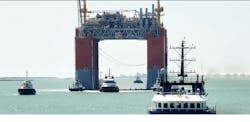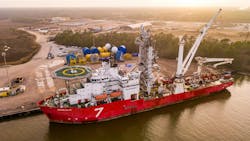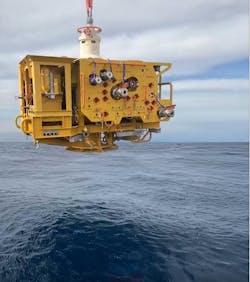Gulf operators ramping up their subsea tieback plans
Bruce Beaubouef, Managing Editor
The US Gulf of Mexico is seeing a surge in subsea tiebacks due to their cost-effectiveness and shorter cycle time compared to standalone facilities.
There are at least eight new tiebacks that will be installed in the US Gulf in 2025-2026, and two more – Shell's Dover and Chevron's Ballymore – have been recently brought online.
The opportunities and challenges of subsea tiebacks were the focus of several operating company officials at a panel discussion held at the recent Offshore Technology Conference in Houston.
At the subsea tiebacks panel, officials from LLOG Exploration Co, Talos Energy, Oxy, Shell, and Beacon Offshore Energy made the case that both producers and operators can benefit from working together on tying back new but smaller fields to existing platform infrastructure.
One example could be seen with Beacon Offshore Energy’s planned Zephyrus tieback in Mississippi Canyon block 759, which will be tied back to the Shell-operated West Boreas subsea infrastructure for further processing before moving onto the Shell-operated Olympus production platform. Michael Clarke, Vice President, Deepwater Developments for Beacon Offshore Energy, said that his company was working with Shell to bring this field online in late 2025. Of the Beacon-Shell relationship, Clarke said that “we are very aligned with Shell in making the Zephyrus field a success.”
Clarke also noted that Beacon had worked with Occidental Petroleum Corp. (Oxy) to develop the Winterfell field in the Green Canyon area through a 13-mile subsea tieback to the Heidelberg spar platform in Green Canyon block 860. Working with Oxy, Beacon was able to bring this field online in July 2024.
Sam Fowler, Subsea Facilities Engineering Manager at Oxy, noted that his company had cooperated with producers on a number of tiebacks in the Gulf. Oxy has ten platforms in the Gulf, so there are plenty of opportunities for tiebacks to these structures, and Oxy has facilitated those relationships, Fowler noted. In addition to the aforementioned Winterfell tieback to the Heidelberg spar, in recent years Oxy has also worked with LLOG on its Buckskin tieback to the Lucius spar; with Woodside on a tieback to the Marco Polo TLP; and with Beacon again on a tieback to its Marlin TLP. For its part, Fowler noted that Oxy is working to upgrade many of its Gulf platforms and extend their lives, so that they will be available to future tieback opportunities.
Glenn Mediamolle, Vice President-Offshore Development with LLOG Exploration, noted that his company had worked with third-party operators on its Taggart field, which ties back to Eni’s Devils Tower spar in Mississippi Canyon block 773, as well as the aforementioned tieback of its Buckskin field to the Lucius spar. Overall, he noted that LLOG had executed 30 tiebacks in the Gulf over the course of its field development efforts.
Talos Energy has also facilitated tiebacks to its platforms from other producers. “We welcome tiebacks from other companies to our production hosts,” said Joseph Sauvageau, Vice President—Asset Development with Talos Energy. He noted that LLOG had tied back its Praline field in Mississippi Canyon block 74 to the Talos Energy-operated Pompano platform in Viosca Knoll block 989 in 2021.
Sauvageau also noted that LLOG had tied back its Spruance discovery in Ewing Bank blocks 877/921 to Talos’ Lobster platform in Ewing Bank block 873. Talos became the operator of the Lobster platform in the wake of its February 2023 acquisition of EnVen Energy Corp.
Sada Iyer, General Manager Projects—Gulf of Mexico for Shell, echoed many of these same themes. “We bring in one to two tiebacks to our platforms per year, and many of these are tiebacks from third-party fields.”
Iyer conceded that Shell had evolved its thinking on allowing producers to access its platforms over the past five years, noting that Shell recognized that it needed to keep its platform hubs operating at something close to nameplate capacity. To do that, it will need tiebacks from other producers. “We’re not [currently] running full on many of our assets. Therefore we will need more tiebacks. We want to invite others. We are open for business.”
Iyer also noted that technical factors will necessitate greater cooperation, particularly on subsea tiebacks. Recent and upcoming discoveries in the Gulf are producing more asphaltenes, he said, and the HP/HT reserves now being brought online are resulting in more scaling than has been seen in the past. “We all need to plan for these things,” Iyer said, including the ways in which topsides equipment will need to be modified to process these reserves.
“There needs to be an enhanced level of partnership on these types of projects, not only between operators of facilities and producers, but with suppliers as well,” Iyer observed. “There needs to more joint industry projects and more collaboration, while still allowing for competition.”
Iyer noted that “subsea volumes are getting more modest” – a trend that will also necessitate more subsea tieback in the future. But he offered an optimistic note about future E&P campaigns in the US Gulf: “The deepwater Gulf of America will have a role to play in the future.” He cited a Wood Mackenzie which indicated that “less than half of the reserves in the Gulf have been produced.”
Recent and upcoming tiebacks
Several subsea tieback projects are scheduled for development in the US Gulf of Mexico this year, with at least two major tiebacks completed within the past few weeks. Below is a rundown of some of the key upcoming projects based on the latest available information.
Ballymore (Chevron)
Sanctioned in 2022, and located in Mississippi Canyon block 607, this project involved three production wells tied back to Chevron’s Blind Faith semisubmersible platform, located about three miles away. It targets 150 million barrels of oil equivalent (MMboe) and is expected to produce up to 75,000 barrels of oil per day (bbl/d) at peak. The tieback was completed and first oil was achieved in April. Ballymore is Chevron’s first development in the Norphlet trend of the Gulf, and this lower-cost tieback enhances production capacity at the company’s Blind Faith platform.
Monument (Beacon Offshore Energy)
Located in Walker Ridge block 316, the Monument field – which contains high-pressure reserves in the Wilcox play – will be developed with two wells and a 17-mile subsea tieback to the recently deployed Shenandoah floating production unit in water depths up to 2,000 meters. Subsea7 secured a contract in December 2024 for the engineering, procurement, construction, and installation (EPCI) of risers, flowlines, umbilicals, and associated structures. Offshore execution is slated for 2026, and forst production is expected in 3Q 2026. The Monument tieback exemplifies the trend toward high-pressure deepwater tiebacks to existing infrastructure. One Beacon Offshore Energy official said that “the Monument development represents the next step in our strategy to commercialize the sizable resource opportunities within tieback range of the Shenandoah FPS in the northwestern area of Walker Ridge.”
Silvertip Phase 3 (Shell)
Located in the Alaminos Canyon, Shell issued the FID last December for this two-well development in the Silvertip Frio reservoir. No information has been provided on the length of the tieback, but the field will be tied back to the Perdido spar in 8,000 feet of water. It aims to recover 17 MMboe and deliver up to 6,000 barrels of oil equivalent per day (boe/d) at its peak. Subsea7 is handling the EPCI for the flowline and tie-ins. First production is expected in 2026. The Silvertip field production is expected to significantly boost output at the Shell-operated Perdido hub.
Zephyrus (Beacon Offshore Energy)
As mentioned above, Beacon Offshore Energy is also planning its Zephyrus tieback in Mississippi Canyon block 759. This development calls for a two well system that is tied back 17 miles to the Shell-operated West Boreas subsea infrastructure. There, it will continue on for further processing at the Shell-operated Olympus production platform. Zephyrus Phase 1 in Mississippi Canyon Block 759 is in water depths ranging from 3,100 to 3,600 ft. Beacon’s initial Zephyrus well in 2023 discovered “high-quality” oil in the Middle Miocene sand. The project will incorporate a high-integrity pressure production system into the nine-mile Zephyrus subsea tieback infrastructure. Beacon is working with Shell to bring this field online in late 2025.
Dover (Shell)
The Dover field is located within Mississippi Canyon, approximately 170 miles offshore southeast of New Orleans, Louisiana, in about 7,500 feet of water. Announced as part of Shell’s 2024 initiatives, this 17.5-mile tieback connects two deepwater wells to the Appomattox production hub. Brought online in April, Shell says that the Dover field brings an estimated peak production of 20,000 barrels of oil equivalent per day. Shell says that Dover is its second subsea tieback connecting new wells to its Appomattox production hub.
Shenandoah South (Beacon Offshore Energy)
Beacon and its partners are advancing plans to develop the Shenandoah South discovery located in Walker Ridge 95 in water depths ranging from 5,800 to 6,000 feet. The field’s proximity to the Shenandoah FPS will enable a “cost-efficient” subsea tieback development to be accomplished via a three-mile flowline and dedicated riser connection to the Shenandoah FPS. Shenandoah South is expected to include the drilling and completion of two wells, with initial production from the first well expected to occur in the 2Q 2028. Beacon estimates a total of 74 MMBOE of P50 resources for Shenandoah South. Beacon is partnering with Houston Energy, HEQ Deepwater, and Navitas Petroleum in the Shenandoah South development which is planned for final investment decision by the 2Q 2025.
The Shenandoah South project would mark the second lower Wilcox subsea tieback that Beacon plans to produce via its Shenandoah production hub. The Shenandoah South and Monument tiebacks, said one Beacon official, “represent the implementation of our strategy to commercialize the sizable, discovered resource opportunities within tieback range of the Shenandoah FPS. When taken together, our Shenandoah, Shenandoah South, and Monument fields are estimated to deliver nearly 600 MMBOE of P50 resources.”
Sunspear (Talos Energy)
Located in Green Canyon block 78, the Sunspear development will be a single-well subsea tieback to the Talos-operated Prince platform, located 12 kilometers (approximately 7.46 miles) to the north. Subsea7 was awarded a contract for the subsea tieback, including the installation of the flowline and related infrastructure. First production is expected toward the end of June 2025.Sunspear is projected to produce 5,000 to 15,000 barrels of oil equivalent per day (boe/d), based on Talos’s completion of similar single-well tiebacks. The Sunspear project leverages existing infrastructure to reduce development costs and expedite production, a common strategy for Talos in the Gulf of Mexico.
Katmai West (Talos Energy)
The Katmai West field is located in the Ewing Bank area near the existing Katmai field. The Katmai West #2 well will be tied back to existing subsea infrastructure connected to the Talos Energy’s Tarantula facility, which has been expanded to accommodate increased production capacity.
Talos had announced a successful oil and gas discovery at the Katmai West #2 well in January 2025, and first production is expected sometime this summer, indicating an extremely fast cycle time. The Katmai West #2 well is expected to have an output of 5,000 to 15,000 boe/d, similar to Sunspear. The discovery at Katmai West #2 is expected to add significant reserves, potentially extending the field’s productive life. The Katmai West project builds on the existing Katmai field, leveraging upgraded infrastructure at the Tarantula platform in South Timbalier Block 308 A to handle additional production.
Longclaw (Murphy Oil)
Located in Green Canyon block 433, Murphy Oil’s Longclaw project is a subsea tieback development that will be tied to the company’s King’s Quay FPU. Murphy had first announced the Longclaw-1 exploration well discovery in May 2023. The length of the tieback has not been specified, nor had the project received FID (or at least publicly announced) as of mid-May 2025. But reports indicate that it could be brought online in late 2025 or early 2026. The Longclaw tieback aligns with Murphy’s focus on high-return, oil-weighted Gulf of Mexico assets. And Longclaw’s location in the Wilcox trend near King’s Quay positions it to potentially support future near-field exploration tiebacks, enhancing the hub’s longevity.
Tiberius (Kosmos Energy)
Located in Keathley Canyon block 964, Kosmos Energy is advancing its Tiberius discovery, which will be tied back about six miles to the Occidental-operated Lucius spar platform. Initial plans had targeted a project sanction in 2024, but this has been deferred to the second half of 2025 as Kosmos progresses development planning, including securing long-lead items. The tieback will leverage existing infrastructure at Lucius, which supports Kosmos’ infrastructure-led exploration strategy, which aims for high-return, fast-payback projects. Kosmos is also actively working on a farm-down of its interest in the field to align with its capital program. According to reports, the project continues to move forward, with the farm-down process expected to conclude around the time of the revised sanction date.
About the Author
Bruce Beaubouef
Managing Editor
Bruce Beaubouef is Managing Editor for Offshore magazine. In that capacity, he plans and oversees content for the magazine; writes features on technologies and trends for the magazine; writes news updates for the website; creates and moderates topical webinars; and creates videos that focus on offshore oil and gas and renewable energies. Beaubouef has been in the oil and gas trade media for 25 years, starting out as Editor of Hart’s Pipeline Digest in 1998. From there, he went on to serve as Associate Editor for Pipe Line and Gas Industry for Gulf Publishing for four years before rejoining Hart Publications as Editor of PipeLine and Gas Technology in 2003. He joined Offshore magazine as Managing Editor in 2010, at that time owned by PennWell Corp. Beaubouef earned his Ph.D. at the University of Houston in 1997, and his dissertation was published in book form by Texas A&M University Press in September 2007 as The Strategic Petroleum Reserve: U.S. Energy Security and Oil Politics, 1975-2005.





